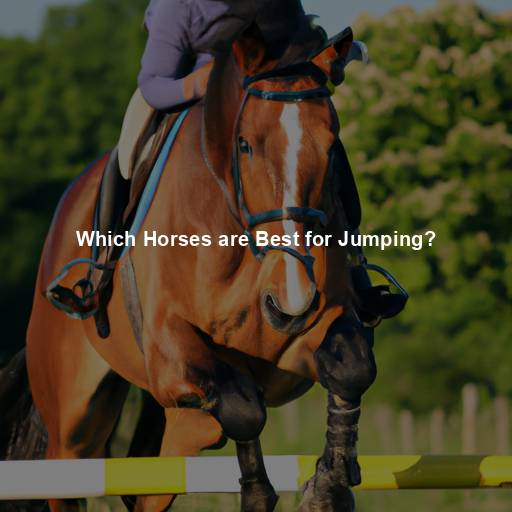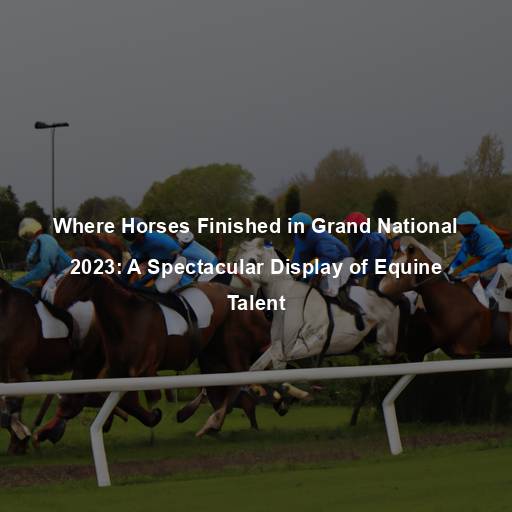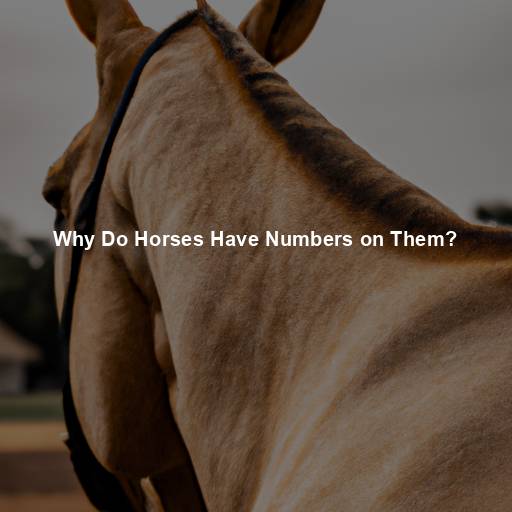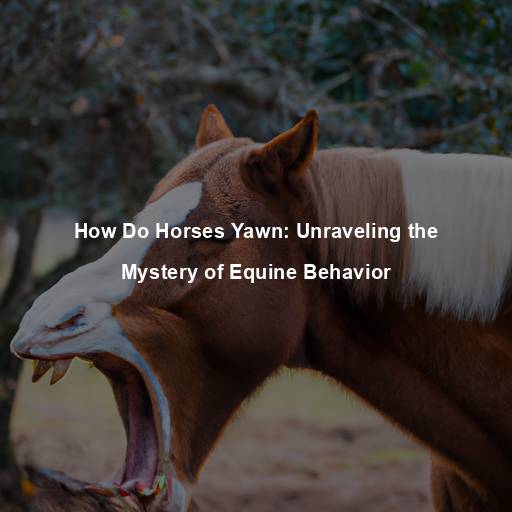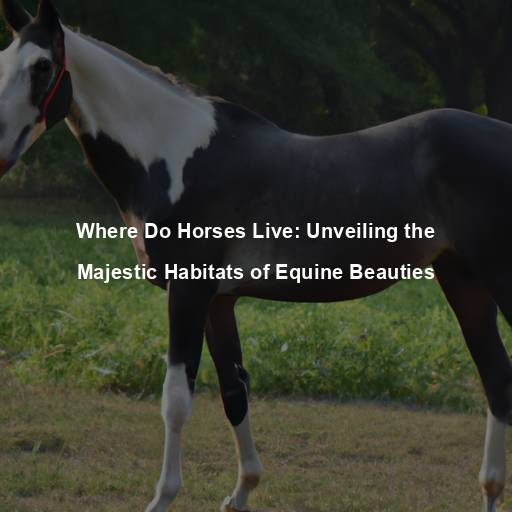Which Horses are Best for Jumping?
Last Updated on July 30, 2023 by Evan
Contents [hide]
- 1 Understanding the World of Jumping Horses
- 1.1 The Importance of Conformation
- 1.2 Breeds Known for Jumping Excellence
- 1.3 The Role of Temperament
- 1.4 Training and Conditioning
- 1.5 Individual Considerations
- 1.6 The Importance of Proper Care
- 1.7 Understanding Jumping Disciplines
- 1.8 Factors to Consider When Choosing a Jumping Horse
- 1.9 Training for Jumping Success
- 1.10 Maintaining the Jumping Horse’s Well-being
- 2 FAQs: Which Horses are Best for Jumping
Understanding the World of Jumping Horses
Jumping horses are a fascinating breed, known for their athleticism, grace, and ability to soar over obstacles with ease. Whether you’re a rider looking to compete in show jumping or simply an admirer of these magnificent creatures, it’s important to understand the qualities that make certain horses excel in this discipline. In this article, we’ll delve into the characteristics and breeds that are best suited for jumping, providing you with valuable insights to help you make informed decisions in your equestrian pursuits.
The Importance of Conformation
When it comes to soaring through the air with grace and power, a horse’s physical form is at the forefront. The intricate interplay of their bones and muscles, known as conformation, can be the key to unlocking their jumping potential. Picture this: a horse with a sturdy build, a well-defined hind end that exudes strength, and a chest that seems to make room for boundless energy. Couple that with a shoulder that slopes with effortless elegance, and you have the ingredients for a truly mesmerizing jumper, capable of defying gravity with each leap.
Breeds Known for Jumping Excellence
While any horse can potentially learn to jump, certain breeds have a natural inclination and genetic predisposition for excelling in this discipline. Here are some of the top breeds renowned for their jumping abilities:
Thoroughbreds: renowned for their breathtaking speed and awe-inspiring athleticism, these majestic creatures have been known to leave spectators and fellow horses alike in a state of sheer wonder. With their elegant long legs, robust chests, and mighty hindquarters, they embody the perfect combination of grace and power, destined to conquer even the most challenging jumping courses. Their exceptional genes have spurred countless successful crossbreeding initiatives, opening up a world of possibilities to further augment their already impressive jumping prowess.
-
Warmblood: Warmbloods, such as the Hanoverian, Dutch Warmblood, and Holsteiner, are specifically bred for jumping and dressage. These horses possess the ideal combination of strength, agility, and temperament required for successful jumping performances.
-
Irish Sport Horse: Bred for versatility, Irish Sport Horses are a cross between Thoroughbreds and Irish Draught horses. They are known for their excellent jumping ability, as well as their stamina and level-headedness.
The breathtaking Belgian Warmblood, hailing from the enchanting land of Belgium, has captivated the equestrian world with its awe-inspiring attributes. Renowned for its formidable physique, harmonious disposition, and inherent knack for soaring through the air, this majestic breed is highly sought after by devotees of the equestrian sport. With its unrivaled combination of strength, poise, and innate jumping prowess, the Belgian Warmblood remains a perennial favorite among the equestrian community. Prepare to be mesmerized by the sheer magnificence of this graceful creature as it effortlessly conquers the world of jumping with its boundless potential.
The Role of Temperament
When it comes to jumping, a horse’s temperament is as important as their physical prowess. The mystifying dance between rider and steed depends on a delicate balance of focus, courage, and a penchant for tackling the toughest challenges. If a horse possesses a tranquil and teachable spirit, they are often the chosen ones, as their ability to perform consistently and cope with the intense demands of competition sets them apart from the rest.
Training and Conditioning
While natural talent and conformation are important, proper training and conditioning are equally vital in developing a successful jumping horse. Jumping horses undergo a rigorous training regimen that includes flatwork, gymnastic exercises, and gradually increasing the height and complexity of obstacles. Regular exercise and conditioning help build the necessary strength, stamina, and muscle tone required for sustained jumping performances.
Individual Considerations
It’s essential to remember that each horse is unique, and individual characteristics should also be taken into account when assessing their suitability for jumping. Factors such as age, soundness, and previous training experiences can influence a horse’s ability to excel in jumping. Working closely with a knowledgeable trainer or equine professional can help evaluate these factors and guide you in finding the right horse for your jumping goals.
The Importance of Proper Care
Lastly, caring for a jumping horse is crucial for maintaining their well-being and performance. Regular veterinary check-ups, proper nutrition, appropriate hoof care, and adequate rest are essential to keep your horse in optimal condition. Additionally, providing a safe and well-maintained jumping environment is paramount to ensure the horse’s safety and minimize the risk of injuries.
Understanding Jumping Disciplines
Jumping, a wonderfully diverse discipline that leaves us in awe, has an array of captivating categories, each offering its own set of intriguing challenges. It is of utmost importance to grasp the intricacies of the particular jumping discipline that has caught your fancy before embarking on the search for the perfect equine companion. From the elegance of show jumping to the adrenaline-fueled realm of cross-country, the world of jumping beckons with its bewitching variety.
- Show Jumping: Show jumping involves navigating a course of colorful fences and obstacles within a designated time frame. The objective is to clear the jumps without knocking down any rails while maintaining a balanced and efficient pace.
Welcome to the thrilling world of eventing! This equestrian discipline is a captivating blend of dressage, cross-country, and show jumping. Hold your breath as you witness the magnificent partnership between horse and rider, where they navigate obstacles with grace, showcase their agility, test their endurance, and execute precision movements. Get ready to be captivated by the dynamic nature of eventing, where every moment is filled with bursts of excitement and perplexity.
- Hunter Jumping: Hunter jumping focuses on style and technique. Horses are judged on their form over fences, including their jumping style, movement, and overall presentation.
When exploring the exhilarating world of equestrian jumping, it is imperative to ponder upon the unique qualities and physical attributes that horses possess. The specialized discipline demands a careful examination of each individual horse’s prowess, as certain equine companions may showcase exceptional abilities in diverse arenas. Embrace the diverse tapestry of equine talent and delve into the captivating realm of jumping with an open mind, allowing each horse to astound you with their distinctive aptitudes.
Factors to Consider When Choosing a Jumping Horse
Experience and Training
When it comes to horses and their ability to jump, experience and training are key factors that greatly influence their aptitude in this field. It is advised to seek out horses that have been exposed to various jumping exercises and have a strong foundation in fundamental flatwork and schooling. Horses with prior experience in jumping are likely to have encountered a diverse range of obstacles, honing their skills in safely maneuvering through them.
Athletic Ability
Jumping requires a considerable amount of athleticism from a horse. Look for horses with a natural ability to engage their hindquarters, push off the ground, and maintain a balanced and rhythmic canter. Horses with well-developed hindquarters and strong, flexible backs are often better equipped to handle the demands of jumping.
Scope and Technique
When it comes to the extraordinary world of equestrian sports, one term that reigns supreme is “scope”. Picture a majestic horse soaring effortlessly over towering jumps, leaving ample space in its wake. It is the epitome of grace, power, and limitless potential. But what exactly does scope entail?
Soundness and Health
When it comes to finding the perfect jumping companion, it’s imperative to pay special attention to the horse’s well-being and physical condition. You want a horse that is in tip-top shape and free from any pesky lameness or health concerns that could hinder their jumping prowess. To gain a deeper understanding of a horse’s soundness, it’s highly recommended to schedule regular veterinary evaluations, with a comprehensive pre-purchase examination being particularly enlightening.
Temperament and Rideability
When it comes to the world of jumping, one cannot underestimate the significance of a horse’s temperament and rideability. Finding a partner with a natural inclination towards teamwork and cooperation is key to achieving success in this dynamic sport. Equally important is a horse’s ability to brush off rider errors with a forgiving spirit. Look for those horses who not only respond to rider cues effortlessly but also remain laser-focused in the midst of the arena, as they tend to be the ones that excel in training and foster progress.
Age and Experience Level
Consider the age and experience level that aligns with your goals and riding abilities. Younger horses may have potential but require further training and development. Older, more experienced horses may have already established themselves in the jumping arena and can offer a more seasoned partnership.
Training for Jumping Success
When it comes to the art of jumping, training takes center stage in forging the path to equestrian excellence. Delving into the realm of equine athleticism, a myriad of vital elements intertwine to mold a horse into a captivating jumper. From mastering the intricacies of technique to fostering an unyielding bond between rider and steed, the journey to soaring heights is one paved with equal measures of awe-inspiring commitment and enigmatic allure. As we unravel the enigma that is training a jumping horse, let us explore the essential facets that underpin this captivating pursuit.
Flatwork and Foundation
When it comes to preparing horses for jumping exercises, laying a strong groundwork in flatwork is a must. This entails focusing on essential elements like precise bending, lateral movements, and seamless transitions. By honing these skills, horses not only enhance their balance and flexibility but also become more attuned to the rider’s cues. Ultimately, this solid foundation allows horses to tackle jumps with confidence and finesse.
Gymnastic Exercises
Gymnastic exercises are an integral part of a jumping horse’s training program. These exercises consist of a series of jumps arranged in a specific pattern, allowing the horse to develop coordination, technique, and confidence. Gymnastics help horses understand the timing and effort required to clear obstacles while encouraging them to use their bodies correctly.
Progressive Jumping Exercises
As our equine companions continue to excel in their jumping endeavors, it becomes essential to incorporate a series of innovative and dynamic exercises that propel their skills to new heights. By commencing with diminutive, uncomplicated obstacles, we lay the groundwork for a steady climb towards more intricate and lofty jumps. This incremental method fosters an environment where our majestic horses can cultivate their physical prowess, hone their precision, and attain the utmost proficiency for the trials that lie ahead.
Course Work and Simulation
As equestrians embark on the exhilarating journey of training their trusty steeds, there comes a pivotal moment where individual jumps gracefully pave the way for full-fledged jumping courses. The artistry lies in meticulously creating a tapestry of diverse fences, unveiling the grandeur of combinations and challenging related distances, as if emulating the breathtaking complexity of show jumping or eventing courses. It is through the deliberate repetition of these meticulously crafted courses that horses cultivate an unwavering focus, remarkable precision, and unparalleled adaptability, thereby unfurling the vibrant tapestry of successful jumping performances.
Conditioning and Fitness
Jumping requires a significant amount of physical fitness and stamina from a horse. Incorporating a conditioning program into their training regimen is essential. Gradually increase the duration and intensity of their work, including regular gallop sets and hill work, to improve cardiovascular fitness and muscular strength. A fit and conditioned horse will be better equipped to handle the physical demands of jumping.
Maintaining the Jumping Horse’s Well-being
Caring for a remarkable jumper is an intricate and perplexing task that demands utmost attention. To unravel the path towards their sustained well-being and unfathomable longevity, several vital aspects require meticulous consideration. Ponder the intricacies of their care and welfare, as we delve into the enigmatic world of these awe-inspiring equine athletes.
Proper Nutrition
A balanced and nutritious diet is crucial for a jumping horse’s overall health and performance. Consult with an equine nutritionist or veterinarian to develop a feeding plan that meets the horse’s specific dietary needs. Adequate protein, vitamins, minerals, and hydration are essential for maintaining their energy levels, muscle development, and overall well-being.
Regular Veterinary Care
Ensuring the vitality of your spirited equine companion is no small feat. To keep your jumping horse in peak physical form, a series of well-choreographed measures should be employed. Remember to choreograph regular vaccinations, dental examinations, deworming, and meticulous hoof care routines to guarantee their utmost well-being. By embracing the practice of regular veterinary evaluations, you can gracefully navigate the delicate terrain of lameness worries and navigate the often uncertain paths to a healthy, flourishing horse.
Proper Equipment and Tack
Using appropriate and well-fitting equipment is vital for the comfort and safety of a jumping horse. Ensure the saddle, bridle, and other tack fit correctly and are suitable for jumping activities. Regularly check and maintain the equipment to ensure it remains in good condition and does not cause any discomfort or injury to the horse.
Adequate Rest and Recovery
It’s no secret that the sport of jumping takes its toll on our trusty equine companions. The sheer physical strain can leave them drained and vulnerable to injuries. That’s why it’s of utmost importance to give these majestic creatures the rest and recovery they deserve. Let them frolic in the open fields, graze on lush pasture, and indulge in well-deserved moments of serenity.
FAQs: Which Horses are Best for Jumping
What traits should I look for in a horse suitable for jumping?
When searching for a horse suitable for jumping, it is essential to look for certain traits. Firstly, a horse with a good conformation, including a well-built shoulder and hindquarters, is important. This enables them to have a strong push-off and efficient jumping ability. Additionally, their legs should be strong and correctly aligned, especially in the hocks and knees, to handle the impact of landing. A horse with a willing and bold nature can also make a great jumper, as they need to be confident and brave when facing obstacles. Lastly, a horse with a good sense of rhythm, balance, and agility will be better equipped to navigate the technical challenges of jumping courses.
What breeds excel in jumping disciplines?
In the mesmerizing world of jumping disciplines, various horse breeds have emerged as true stars, leaving both riders and spectators in awe. Among these, the remarkable Dutch Warmblood reigns supreme, captivating all with its unparalleled athleticism, raw power, and boundless scope. Yet, the jumping arena boasts a kaleidoscope of talent, with other exquisite warmblood breeds like the Hanoverian, Holsteiner, and Belgian Warmblood commanding great respect. Meanwhile, Thoroughbreds mesmerize with their lightning-fast speed and unwavering endurance, qualities that seamlessly translate into the art of jumping. Irish Sport Horses and their crossbreeds with Irish Draughts are hailed for their remarkable jumping prowess and unmatched versatility. And let us not forget the ponies, who, despite their smaller stature, possess an enchanting ability to conquer the heights, as exemplified by the Welsh Pony and the Connemara Pony. Together, these resplendent equine athletes elevate the world of jumping into a realm of pure splendor and astonishment.
At what age can a horse start training for jumping?
Determining the ideal age for a horse to embark on the remarkable journey of jumping is a multifaceted puzzle. To solve it, we must unravel the threads of their physical progress and mental preparedness. As a general guideline, around the age of four, after they have completed their fundamental groundwork and acquired rudimentary riding skills, horses can dip their hooves into the world of basic jumping. This timing allows for an essential formation of obedience and equilibrium, laying a sturdy foundation before introducing the exhilarating demands of soaring over obstacles. Yet, the enigmatic realm of equine development unveils a myriad of individual idiosyncrasies, with some horses blossoming earlier or later than the norm. Navigating this labyrinthine terrain calls for seeking counsel from seasoned trainers and astute veterinarians, who possess the wisdom to discern the ideal juncture for each individual horse’s inaugural leap towards greatness.
Can any horse learn to jump?
Jumping, an exhilarating equestrian endeavor, demands more than just the spirit of a horse. It demands innate physical prowess, impeccable coordination, and a natural flexibility, all of which differ from one equine companion to another. Furthermore, not every steed possesses the temperament or disposition to readily tackle the tests that come with jumping. Nevertheless, with careful nurturing, meticulous attention, and the right equine partner, countless individuals can emerge as formidable jumpers. It is vital to thoroughly evaluate a horse’s build, character, and athletic potential before determining their suitability for this electrifying discipline.
Do horses need specialized training for jumping?
The realm of equestrianism demands a unique journey for our equine companions who aspire to conquer the art of jumping. Foundational principles, such as cultivating a firm understanding of basic riding skills and honing their flatwork finesse, serve as vital stepping stones towards a prosperous jumping career. This intricate process accentuates the significance of nurturing a horse’s balance, fostering a sense of straightness, and fostering a harmonious relationship between horse and rider. Implementing a gradual approach, our majestic athletes are gradually exposed to the realm of jumping through purposeful introduction to small jumps and grids, thereby instilling confidence and comprehension of this intricate discipline. Subsequently, as the horse evolves, more complex exercises and courses make their appearance, unveiling additional layers of technicality to refine their prowess and unleash their untapped potential. Moreover, a consistent, patient, and methodical approach, often with the expert guidance of a seasoned jumping trainer, becomes an indispensable catalyst in unlocking the horse’s true mastery of the jumping realm.

